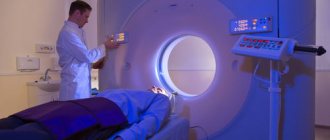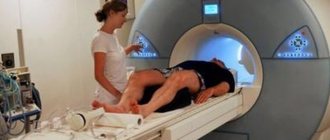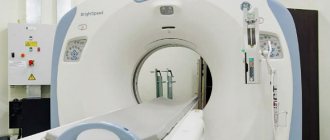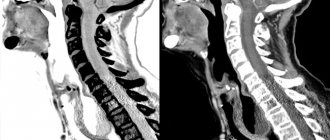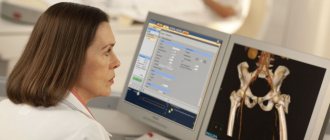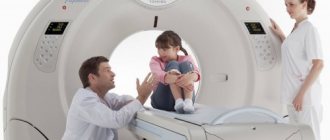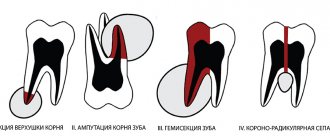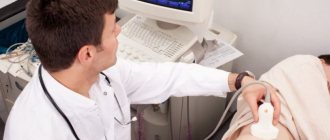Harm from a computed tomography (CT) scan
It often happens that the harm of CT scans to the body is significantly exaggerated, but the negative impact of X-rays on the body cannot be denied. X-rays are ionizing radiation that affects the human body with a certain power and different intervals. The harm from this radiation is as follows:
- it temporarily changes the composition of the blood;
- ionizes body tissues;
- can change the structural composition of proteins;
- may contribute to premature skin aging;
- causes disturbances in the process of life and maturation of body cells;
- may contribute to the development of cataracts;
- can contribute to the degeneration of body cells into pathological ones.
It becomes clear that the result of such exposure can be various diseases, including the risk of tumor diseases. But it should be noted that the harm from CT to the body is minimal, since all precautions must be observed. Modern devices produce low-energy X-rays that do not accumulate in tissues. It is also important to know that the susceptibility of different tissues to these rays is completely different.
Dangerous field
Let's start with electromagnetic radiation, its source is the monitor and the computer system unit. In the human body, many processes occur according to the same laws that prevail in physics - using electromagnetic radiation, impulse transmission, and so on. First of all, the speed of impulse transmission along nerve endings is important. For some, these impulses “run” faster, for others slower. If a person has a tendency to so-called “paroxysmal activity”, the “readiness” of the nervous system to issue the wrong signal, “abracadabra”, is higher. For example, if a person with such a predisposition has any pathology, then it is more likely to manifest itself if his work is related to a computer than in a person who does not come into contact with a computer. Electromagnetic field, what is its harm? An electromagnetic field can affect the transmission of impulses along nerve endings. And this is a manifestation of any disease - from malfunctions in the autonomic nervous system, which “nerves” all internal organs, to pathology of the central nervous system, which ensures mental activity. Manifestations can be different - dizziness, neuroses, fatigue, increased drowsiness, neurological diseases - tics, pain. To avoid prolonged contact with the electromagnetic field, you need to periodically leave your workplace at the computer, in this way you will “kill two birds with one stone,” because constant work at the computer is both a static load and a sedentary lifestyle.
| Neurologist, Ph.D. Novikova Larisa Vaganovna . Let's start with the fact that there are specific, so-called “computer stressors”. For example, loss of information. Unstable operation, crashes and computer freezes, even those that do not lead to data loss, are also serious stress factors. Remember your reaction when several pages of text you just typed disappear from the screen or your favorite toy stubbornly refuses to start. You begin to lose your temper and get nervous, and this negatively affects your nervous system. Try to be calmer about these excesses, remember that nerve cells do not recover. In addition, people who are forced to spend the whole day at the computer experience memory impairment, insomnia, blurred vision, headaches, chronic fatigue, and depression. Moreover, these symptoms become more pronounced as work experience increases. Don’t take the situation to the extreme, get more rest, try not to lie at home on the couch with a book on the weekends, go for a walk, ride a bike, or go swimming. |
Radiation doses on old tomographs
Every person who is about to undergo a CT scan asks the question “What harm can a CT scan cause to health?”, and these experiences are absolutely normal. The radiation dose that the patient receives during the examination is 100-1000 times greater than during conventional radiography. But it is important to know that the dose directly depends on how modern the tomograph is used. Too high radiation doses are characteristic only of old devices, still of Soviet origin. Modern equipment provides a minimal dose of radiation, so there will be no harm from CT scanning.
Cone beam computed tomography: harm
This procedure is a type of 3D computed tomography. This method differs in that it is used primarily in otolaryngology, dentistry and maxillofacial surgery. The harm of cone beam computed tomography to the body is minimal, since the radiation dose during diagnosis is about 50-130 microsieverts. For comparison, it is worth knowing that the natural background radiation is about 1000 microsieverts per year, and the maximum dose for human life is considered to be 5000 microsieverts per year. Therefore, there is practically no harm from this type of computed tomography.
"Sedentary" diseases
In a sitting position, the bending of the hip joint leads to pinching of the blood vessels, and blood begins to flow more slowly. In men, a “sedentary” lifestyle can lead to stagnation of blood in the pelvis, disruption of the prostate gland, prostatitis and even impotence. In women, poor circulation can aggravate any gynecological disease - fibroids, cysts. It is known that inflammatory processes in the pelvis with poor blood circulation are more severe.
| Proctologist, Ph.D. Predybaylo Sergey Mikhailovich . A sedentary lifestyle, of course, negatively affects a number of proctological diseases, but the most common disease that develops during “sedentary” work is hemorrhoids. People whose work involves a computer are recommended to periodically get up, walk around, and do some exercises so that the muscle pump in the legs drives the blood away. If you are at risk, then if you experience itching, burning in the anus, or pain during bowel movements, try to quickly consult a proctologist. |
Advantages of CT on new tomographs
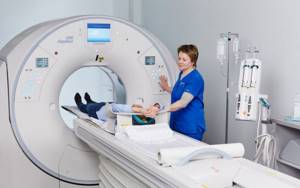
Technology does not stand still and scientists around the world are making every effort to improve various devices for studying the body and making diagnoses. Before talking about how dangerous computed tomography is, the harm from which cancels out its benefits, it is worth knowing that this applies only to old equipment. It often happens that patients want to save on expensive examinations and undergo diagnostics using old devices, thereby putting their health at risk. According to research by American scientists, about 2% of cancers are provoked precisely by examinations on harmful old-type tomographs.
Modern tomographs require minimal radiation exposure to the body and, accordingly, minimal risk of damage to health. But as a result of such an examination, doctors receive valuable information about the condition of all body structures and prescribe effective treatment.
Common myths about CT scans
Myth 1. During computed tomography, the program analyzes and issues a conclusion without human intervention
A very common misconception. The analysis of the data obtained from CT is carried out by a doctor, and the conclusion is drawn up by him. Of course, there are programs that make it easier to search for pathology, for example, lesions in the lungs (as well as programs for determining the severity of hydrocephalus), but they - at the moment - cannot replace a live interpreter.
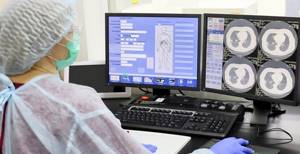
Myth 2. Computed tomography allows you to reliably make a diagnosis
And this statement is false. CT is a very highly informative diagnostic method, but the diagnosis is made by the attending physician based on the data of all studies - laboratory, x-ray, clinical. You should not try to determine the histological structure, for example, of a tumor using CT - only a qualified histologist can do this.
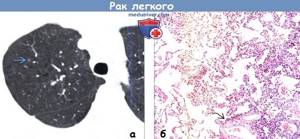
Myth 3. Computed tomography is indicated for gastritis, colitis and gastric ulcers
No, other research methods are more suitable for identifying these diseases: FGDS or fluoroscopy of the stomach to diagnose peptic ulcers, colonoscopy to diagnose colitis, a blood test for antibodies to helicobacter pylori to diagnose gastritis, etc.
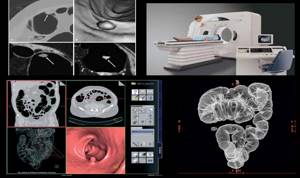
Myth 4. MRI is a much more informative research method compared to CT
And this is also a misconception. For diagnosing bone trauma, destructive, tumor processes in the bones, CT is a much more informative research method. Due to the high (compared to MRI) degree of visualization of changes in bone tissue and the speed of implementation, it is the method of choice (and the primary study) for traumatic brain injury, spinal injury, damage to skeletal bones, etc.

But this is not entirely a myth. The radiation exposure is really high, but the effective dose per examination can range from 0.1 mSv (for tomography of the extremities) to 30 mSv (for tomography of the abdominal organs with contrast). If in the first case the effective dose can be compared with the dose from a single x-ray film, then in the second case - with the dose obtained as a result of 1000 or more digital x-rays.
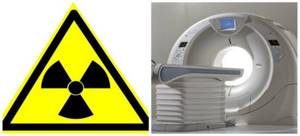
Myth 6. The more slices, the higher the quality.
And this is not entirely true. Of course, 128-slice tomographs make it possible to analyze finer structures of the body, but 16-, 32-, and 64-slice devices are also sufficient for use in clinical practice. An increase in the number of slices naturally leads to longer scanning times and an unjustified increase in dose.
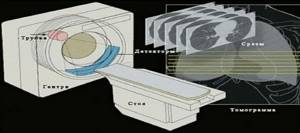
. Of course not. In addition to CT, there are many different studies that make it possible to more reliably diagnose pathological conditions - for example, fibrobronchoscopy if a bronchial tumor is suspected. Computed tomography has its own area of application, and it should be performed only if there are compelling indications.
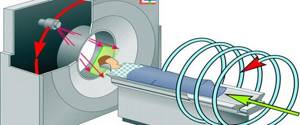
Myth 8. CT can be performed for preventive purposes
. Indeed, screening CT can take place (for example, CT of the chest with thick sections), however, despite their greater information content compared to “standard” fluorography, they are used in few places in Russia - due to relative high cost and greater patient exposure.

Myth 9: CT with oral and intravenous contrast is equally effective
Often, instead of injecting contrast into a vein, it is taken orally. This is incorrect in the case when it is necessary to determine, for example, the presence of a soft tissue component in a kidney cyst, and, moreover, to perform angiography. Of course, from the stomach contrast (Ultravist, Omnipaque, etc.) enters the blood, but slowly, and in this case it is impossible to achieve “classical” phase separation on CT. Here you should remember: when it comes to diagnosing aneurysms and tumors, intravenous administration of contrast is necessary.
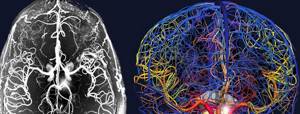
Myth 10. CT and MRI have the same operating principles
In both cases we are talking about tomography - obtaining layer-by-layer images of the body, but the method of obtaining these images is different in each case. With MRI, images essentially reflect the distribution of hydrogen ions (protons) on a section, and with CT, tissues of different densities for X-rays are displayed in different shades of gray. During MRI, a person is exposed to a strong (0.3 - 1.5 Tesla or more) magnetic field, and during CT - electromagnetic radiation.
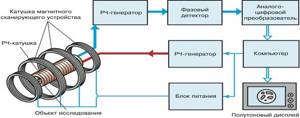
How often can a CT scan be done?
The procedure is not recommended to be performed more than once a year, due to precautionary measures and prevention of exposure to radiation to the body. Otherwise, the harm from CT diagnostics will significantly exceed the benefits of it, since you may encounter various diseases caused by exceeding the dose of radiation exposure to the body.
CT head
If you need to examine the brain, the harm from a computed tomography scan will also be minimal if you do not exceed the amount of permissible radiation exposure per year. Therefore, it is also not recommended to undergo a brain tomography.
more than once a year. In case of severe illnesses, the doctor may decide to increase the number of these procedures to three per year, and the interval between them should not be less than one month. Other radiation exposures, such as x-rays, must be taken into account.
Ergonomics will fix the hunchback
Speaking about a sedentary lifestyle, first of all, of course, we need to talk about the spine, because it probably suffers the most. All nerve endings come out of the spine, so when we sit for a long time, the spine gets tired; the muscles of the back, abdomen, the so-called “muscle corset” must maintain it in the correct position. If the muscles are not trained, the corset will not be strong enough, the spine will begin to “caking”, “sagging”, the vertebrae will begin to put pressure on each other, which will lead to disruption of innervation. In this case, muscle pain in the back and abdomen may occur. Take care of the ergonomics of your workplace. First of all, pay attention to exactly how you sit at the computer. A rationally selected work chair or armchair will help you maintain correct posture, in which your spine will not strain. The back of the chair should support the lower half of your back, but not be rigidly fixed and not interfere with your movements while working. As for the table at which you will work, its optimal height is considered to be 75-85 cm from the floor (for a person of average height).
| Doctor chiropractor Borisov Alexander Borisovich . Staying in one position for a long time leads to a constant load on some muscle groups and its absence on others. If constant overstrain of muscles leads to pain, then lack of load has a more detrimental effect on your body as a whole and leads to muscle degradation. As a result, curvature of the spine, destruction of intervertebral discs - osteochondrosis. To prevent curvature of the spine, you need to lead an active lifestyle, eat right and monitor your posture and body position in which you spend most of the time. Pay attention to your workplace: everything should be located so that you do not have to stay in the same position for a long time. And most importantly, get up from the table as often as possible, warm up, and do some movement. |
We typed, wrote, our fingers were tired
After several hours of working on the computer, have you felt tingling, numbness, or even tremors in your fingers or pain in your wrists, especially your right hand, with which you were holding the mouse without letting go? For those who work a lot on the computer, such symptoms are not news. Hand gymnastics is especially important for such people. Despite the fact that a person makes a lot of movements when typing, these movements are of the same type, they only create a load on the joints. The best “medicine” is breaks from work and special gymnastics – circular movements of the hands.
| General practitioner, rheumatologist, head of the diagnostic and treatment department Orlinskaya Irina Nikolaevna . The main cause of the so-called “carpal tunnel syndrome” is prolonged monotonous work with the hands and fingers. This disease affects people of various professions: draftsmen, secretaries, musicians, drivers, assembly line workers. One hundred or two hundred years ago, carpal tunnel syndrome was an occupational disease of clerks who copied various papers from morning to evening. And in our time, users of personal computers suffer greatly from it, who spend many hours making monotonous small movements with their hands, moving the mouse or typing on the keyboard. The main task in the treatment of tunnel syndrome is to achieve decompression (reduction of pressure) of the contents of the anatomical canal in which the nerve has been compressed. In the early stages of the disease, this is achieved through therapeutic methods. In more severe cases, surgical intervention may be necessary - dissection of the fibrous canal, revision of the nerve. But it’s better, of course, not to let it come to that. To prevent prolonged work on the computer from leading to carpal tunnel syndrome, it is enough to follow simple recommendations for organizing your workplace and work schedule: take short breaks every hour, during which you perform several exercises for your hands. |
